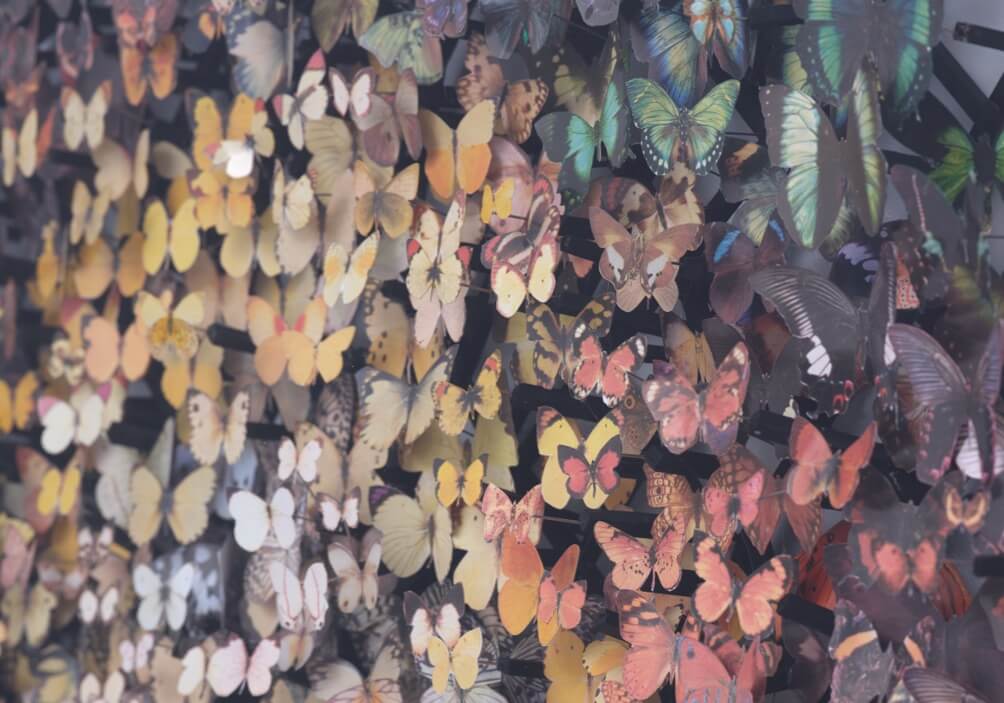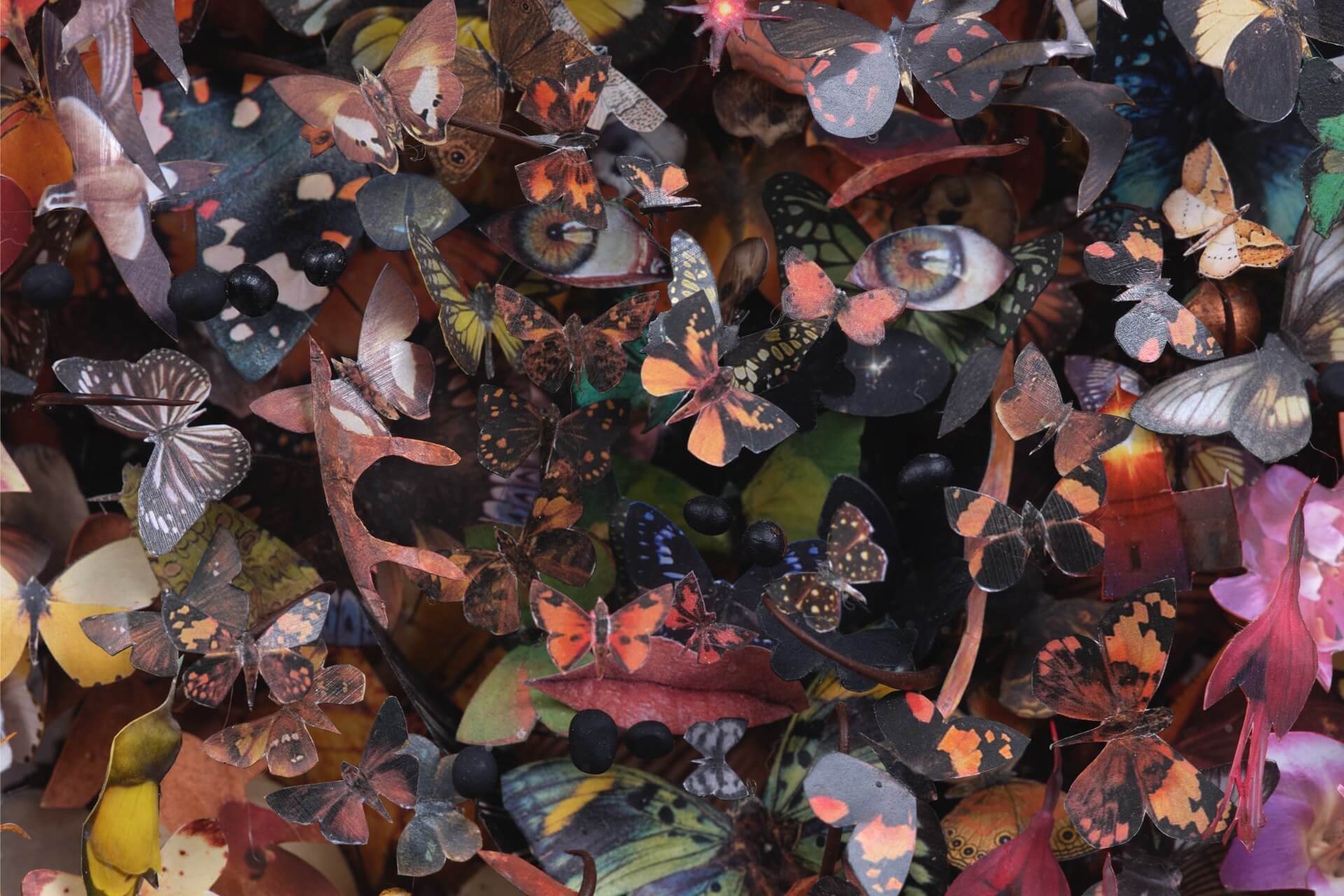Feb 24, 2024 People
On a wet July afternoon, I join Jacqui Knight, president of the Moths and Butterflies of New Zealand Trust Pūrerehua Aotearoa, on a trek through a rugged, bush-covered hillside of Blockhouse Bay. We’re on the hunt for the miraculous — Auckland’s monarch butterflies in their winter retreat.
Earlier in the season, my hunt had taken me north to Butterfly Bay, near the Whangaroa Harbour. One might reasonably take from the name that the bay would be an El Dorado of the wondrous monarchs, but I found scarcely any — just a nice sandy beach and a couple of seedy motels. A better destination, according to the local camping-ground proprietor, was the less obviously named Tauranga Bay. (“They fucked it up,” he tells me, “the butterflies are over the hill.”) Once there, I found a giant swan plant, 2m tall, that got my hopes up. But still the north was nowhere near the Rhopalocera mecca I was looking for.
Here in Blockhouse Bay with Jacqui, I find what I am looking for — branches drenched in gorgeous monarchs. When sunlight bursts through the wintery clouds they lift and move like waves. These aren’t like the mountainous pine forests in Mexico, where billions of migrating monarchs catch their breath after travelling south in colonies of 20 million from Canada and many parts of the United States, but at least I have found local proof that monarchs overwinter, and discard the old legend that says they live only for a day. These gloriously fascinating insects, official name Danaus plexippus, have become the life’s work of my guide. For the past 40 years, she has been their champion and advocate.
I first met Jacqui five years ago when she talked me into being the patron of the Moths and Butterflies trust. Together we have been searching for a location to establish a National Butterfly Centre, as a tourist destination and a place where New Zealanders can walk amongst butterflies in a huge aviary-like enclosure and watch these gentle beautiful creatures fly freely. The trail has led to two options — Tūī Glen Reserve in Henderson (the site of Aotearoa’s first camping ground) or a council-owned site on Grafton Rd. Jacqui’s mission is to see New Zealanders rediscover the extraordinary world of insects, in which the butterfly is but one inhabitant.
New Zealanders are crazy about gardens — go to any garden centre on a long weekend and you’ll see it — and insects, butterflies and moths thrive in lush backyards around Aotearoa. Jacqui explains to me that in spring, when the days grow longer, monarch butterflies will come again and again to your garden to breed. They continue this cycle until the end of summer, when the days start shortening and they sense it’s too cold. They will now need a place to shelter over winter. Jacqui is terrified that if Auckland continues developing the way it’s going — the spread of concreted suburbs into the countryside — the butterflies that are so important to us and our children will disappear altogether.
Jacqui Knight was once married to the famed cricketer Mark Burgess and wrote a memoir, New Zealand: Bit by Bit, about her journey on horseback down the length of the country with four horses and a dog while broadcasting the trip to Radio Pacific. The journey was inspirational, and helped spur on her mission to share knowledge about the travelling monarch and its strategies for survival.
The monarch was first promoted in New Zealand in the 1930s by a man named Tom Skeates, born in 1888. Skeates had read a passage in Rev William Colenso’s diary from the 1870s about finding a glorious butterfly on trees in Hawke’s Bay. Colenso had never seen such a beautiful insect before, and praised its soaring and flying ability. The account is one of the first written records of a butterfly in these islands — though FH Meinertzhagen, from Waimārama in Hawke’s Bay, said that local Māori had told him they’d known about monarch butterflies long before the arrival of European settlers and knew them as kahuku. Their continuing survival, however, depended on the swan plant, which was introduced in the mid-1800s. Colenso wasn’t to know that monarchs are both common and ancient — an African queen variety is depicted in a fresco on an Egyptian tomb from 3500 years ago. The monarch that Colenso saw might have reached New Zealand from Australia, where it’s widely known as the wanderer, but Jacqui believes it could have soared all the way from Mexico. On arrival in New Zealand, it hooked up with a few other stragglers to create the population later found by Tom Skeates in the Waitākere Ranges.
Like Jacqui, Skeates became obsessed with the monarch and in the mid-1930s started collecting larvae from around Titirangi to raise them. He began travelling around Auckland visiting schools to release his butterflies, to the delight of local schoolchildren, and mailed swan plants and chrysalises to other schools in carefully packed boxes. Skeates’ knowledge was extensive — he established that monarchs were capable of flying hundreds of kilometres — and anyone interested in the butterfly came to visit him to discuss them, or help him release the monarchs in the Domain and Albert Park. After becoming well known in Auckland as ‘the Butterfly Man’, Skeates died in 1945.
I remember Skeates’ house well in the 1960s, at which time it was deserted in a grove of kauri trees on Scenic Drive, as eccentric as the man himself and falling into serious disrepair. While the house was later demolished, Skeate’s legacy lives on. He is an icon and a hero to Jacqui, and she wants to name the first butterfly house in his honour.
The monarch butterfly itself is an extraordinary creature. When a caterpillar emerges from its egg, deposited by a female on the underside of a swan plant leaf — an egg so tiny that it’s no bigger than the head of a pin — it immediately starts feeding on the plant. Within two weeks, the larva chewing its way through the leaves will be 2700 times its original weight. (A 3.5kg baby that grew at the same rate as the caterpillar would weigh over 9 tonnes.) The larva will shed its skin five times as it increases in size, and the last and final shed occurs when the developed caterpillar, now huge and unrecognisable, stops chewing its way through the plant and starts seeking a limb or an overhang nearby. In this next phase, the caterpillar weaves a thick silky mat with which it attaches itself to the limb. Hanging curled up, head downwards, from the silken threads, it twists and dislodges its last larval skin to reveal the next stage, which is the pupa. This is initially a vivid green pouch studded with an emperor’s cloak of gold spots, until the metamorphosing insect inside starts developing the glorious colour on its soon-to-be wings. The entire process inside the beautiful casing takes two weeks, until finally the butterfly cracks open the transparent chrysalis and the adult emerges into the world. It does this with great care, clinging on to the empty chrysalis with its feet as it pumps body fluid into its limp, unfolding wings. After the wings dry, the butterfly will give it a couple of trial runs and then soar upwards and outwards, starting the cycle afresh. The whole process from a minute egg to the butterfly takes five weeks.
On the American continent, the migratory cycles of the monarch butterfly baffled scientists and butterfly lovers for 200 years. From the late 1930s, scientists learned how to tag butterflies and track them south, but lost sight of them in Texas in autumn. Then, in 1975, wintering populations were discovered in Mexico. The answer to the mystery, the reason that the butterflies took their enormous trip across the continent and returned in spring, turned out to be the particular conditions of the oyamel fir forests on their 9000-feet-high mountain slopes. There in Mexico, the temperatures are cool (but not the freezing snows of the north), which lower the body temperature of the insects and allow them to conserve their priceless body fat for the return journey north. Sunshine and water are plentiful. It was a sensational scientific discovery. The scientists commenced tagging the Mexican butterflies — a difficult process in itself, to adhere labels to up to 10,000 wings — and were able to locate them again in Canada and Washington state. The research was of huge importance to the insect world, and helped to chart the enormous power of the winged flights of the butterfly. A monarch flying solo, the scientists learned, can travel at speeds of 10–30km/h.
The monarchs that we see in Auckland are many, many generations removed from the wayward individuals who island-hopped across the Pacific from the American continent, arriving in northern New Zealand and then moving down to the Auckland region. Now it’s here, the monarch does not like going past Taupō, and it’s rare to find more than a few winging their way around Wellington.

The monarch is a gateway insect, a good introduction to the world of moths and butterflies. Jacqui helps me start a search for other insects around the Auckland area; it’s quite a job to understand the full scope of these amazing, multitudinous species. We start at the less glamorous end, looking at flies, or Diptera — long-lost cousins of the colourful Lepidoptera. Erica McAlister’s The Inside Out of Flies becomes our bible, an enlightening map for our voyage of discovery. There are kissing flies and farting flies and tickling flies, I learn — nuptial gifts, sex, rituals and suicidal matings. Flies listen to our conversations — they’re thought to love the sound — and know when we’re coming for them. And any undertaker will tell you that when you die, your first visitor will be a blowfly looking to use your body to reproduce. A body left outside in warm weather, a scientist mate of mine informs me, will have its flesh devoured by insects within a week.
Next, looking for caterpillars, Jacqui and I head out to the west coast. All New Zealanders over the age of 40 will remember that a road trip in summer in the 1970s or 80s would involve breaks to clean bees, wasps and flying beetles off windscreens and wipers and, for those who owned a Morris Minor, the grille as well. Now that’s a thing of the past — you can drive from Auckland to Wellington these days and not hit a single insect. Something has changed. Perhaps we can blame climate change, but I have a feeling this one is pesticides and chemicals. Our war on the flying world has taken its toll.
Finding caterpillars is not easy. First, we need a sheet of white paper to catch them as we shake them from the small trees and bushes that surround the sand dunes on Auckland’s West Coast. After a day’s work, and even in this pesticide-drenched world of reduced populations, we have found a surprising number of caterpillars of different species hiding among their leafy shelters. Every butterfly and moth we see flying was once a larva, and yet even in the scientific world there is a lack of information about and research into the humble caterpillar. We simply don’t know the full story of how they came to evolve — what they once looked like, how they survived harsh elements and what they fed on — and they are rare in the fossil record. It is thought, however, that butterflies and moths descend from a common ancestor alive during the late Carboniferous Period, a time pre-dating dinosaurs. This means they’ve had 300 million years to get smart, and they are.
Most of the smallest caterpillars have 12 eyes, six on each side. Their whole-body transformation is simply amazing. And they have developed some of the natural world’s greatest camouflage. They can ‘transform’ in seconds into a leaf or twig, and if that doesn’t work they can fire toxic gas from portals in their sides towards hovering birds. It’s a warning that works. Some caterpillars have incredible arsenals of toxic firepower to ward off predators, and it’s necessary — their survival rate depends on seeing off these hungry and hovering eaters. Here in New Zealand, the German wasp, a recent intruder to the country, is their deadly enemy. With cunning ability, a wasp will alight on the creature and suck the internal organs in a feeding frenzy, leaving it a deflated pile of skin.
It would be wise not to underestimate them. We should remember, Jacqui says, that all moths and butterflies have undergone a remarkable metamorphosis. Before you reach for the Raid or the fly swat, stop and appreciate that beetles, flies, wasps and almost every creepy crawler you can think of is a master of transformation. They have all had times of wriggling free, escaping from their old skin just as we ease out of a wetsuit. They even lose their old heads, dropping them off as they get ready for their new outing.
Over the months I spent with Jacqui, I became more and more amazed at what she was about. She believes (as I now do) that even as we discover new insect species and begin to trace the planet’s real diversity — it is estimated that there may be millions more insect species than the one million we have described and named already — we are on the cusp of losing them. The world’s population of flowering plants depends on insects for their survival, meaning that insects are critical to our own existence. Without them, we lose our food source. All this means that education about monarchs, if it gets kids excited and leads to broader appreciation of insects, is a small but useful step towards the better conservation of these ecosystem helpers.
The monarch butterfly, I’ve learned, feels through its feet. It can differentiate the sugars and nectars of different flowers. Monarch mating rituals, which we can spot in any garden, are often dramatic and brutal, and the transfer of male spermatophore to the female can take hours. It’s the same elsewhere in the insect world. There is much spitting, whittling and other bizarre occurrences in this generational dance — insects can leave nothing to chance in the effort to keep the whole thing going. You’ll be able to see it this summer in your own garden, as those wintering butterflies I saw in July disperse and continue the cycle. And one day, all of this will be part of the rich experiences on offer at Jacqui’s proposed Butterfly Centre. I can’t wait to take my grandkids into the ancient world of Jacqui’s passion.






